| Flag |
Date |
Use |
Description
|
Independence movement
|
 |
1930s-1963 |
Some of the many variants of the flag used before it was standardized |
|

|

|

|
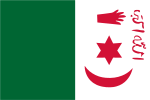 |
1940s–1960s |
Some of the many variants of the flag used by Algierian nationalists before gaining independence. |
|
 |
|
 |
1945 |
|
A Horizontal Bicolour of White and Green with a red hand, a crescent moon, a 6 pointed star and an Arabic script written in red in the canton. The script reads Allahu Akbar ("God is great"). [15] |
 |
1940s |
|
A horizontal tricolour of green (top), white and green with a red hamsa and a red crescent moon. |
 |
A horizontal tricolour of green (top), white and green with a yellow hamsa.
|
|
|
 |
1832–1847 |
|
A horizontal tricolour of green (top), white and green centered with a golden hamsa cricled by an Arabic script. |
 |
1830s–1840s |
|
Yellow-black-yellow tricolor, with hamses placed on all stripes, respectively from the top, at the hoist, in the middle and on the flying side.
|
 |
The flag captured by the French with the Emir's tent |
A red flag with blue lines, horizontally in the middle and vertically along the hoist.
|
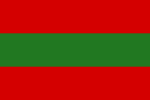 |
pre 1843 |
The flag captured by the French |
Red-green-red tricolor.
|
 |
1850s |
|
4 horizontal stripes of blue, green, yellow and white.
|
|
|
 |
1516–1830 |
|
Various versions of the flag with red, yellow and green stripes
|

|

|
 |
17th century–1830 |
|
A horizontal triband of red (top), green and red with 2 crossed swords in the lower red band.
|
 |
?–1837 |
|
A scarlet silk flag, bordered with a green border and divided into two parts by a green stripe. The border and the stripe are covered with Arabic characters; the remaining parts of the field are dotted with round shields, representing the different phases of the moon. This flag was taken from the great mosque of Constantine during the capture of that city on 13 October 1837.
|
 |
17th century–1830 |
Religious holiday flag of the Regency of Algiers |
A green embroidered silk flag on which is embroidered arabic text, that means "With God's help, the conquest is near".
|
|
|
 |
1516–1546 |
|
A green swallowtailed field with 2 crossed swords in the center, a 6-pointed pentagram in the fly, 4 crescent moons in each corner and the Shahada or Muslim creed written in the Thuluth script in white in the hoist side.
|
|
|
 |
18th–19th century |
|
A white field with an Arabic script written in gold in the center. The text means "Help comes from God, and victory is near". [16] |
 |
1871 |
|
A white field with an Arabic script written in gold in the center and 5 Fleur-de-lis on the hoist side. [17][18] |
 |
18th–mid–19th century |
|
A horizontal triband of red (top), green and red with an Arabic script written in gold in the center. The text means "God is the best helper". [19] |
 |
1850s |
Flag captured by the French army in the Djurdjura mountains during the conquest of Algeria and attributed to the kingdom of Kuku, but may also originate from Aït Abbas. [20] |
A red field with white hamsa in the center and four crescent moons in the corners.
|
 |
14th century |
|
|
|
|
 |
early 14th century–1556 |
|
A white field with a blue crescent moon in the center. [21] |
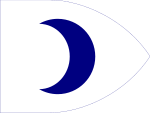 |
14th century |
|
 |
c. 1489 |
|
Blue field with white crescent moon in the center.
|
 |
13th–early 14th century |
|
A white field with a red crescent moon in the center and 3 fringes on the fly. [21] |
 |
|
A white field with a red key and crescent moon in the center and 3 fringes on the fly. [21] |
 |
14th century |
|
A white flag with the black or red seal of Solomon. In the Middle Ages it was an important port of the kingdom of Tlemcen ruled by a council of sheikhs, it is now a ruin near Gouraya. [22][23][24] |
 |
Flag of Brischan under Zayyanid dynasty, according to Catalan Atlas |
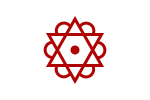 |
Flag of Brischan under Zayyanid dynasty, according to Guillem Soler |
Other
|
 |
14th century |
|
Horizontal white and yellow bicolour.
|
 |
|
A white flag with the black crescent moon.
|
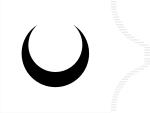 |
|